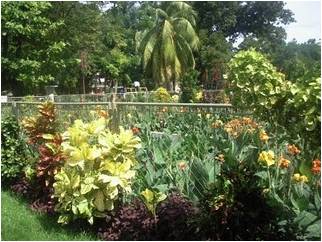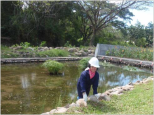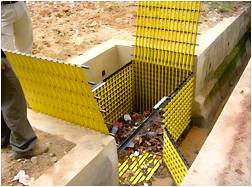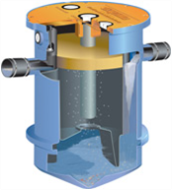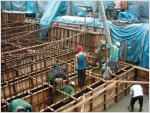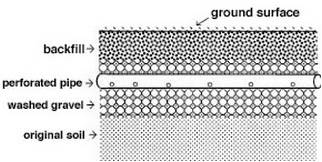Practitioner's Tool / Project Description and Treatment
Which description fits best your project?
Contents
Residential Housing
Wastewater systems for housing generally require a three stage treatment process. The first stage uses a septic tank or other anaerobic process to remove much of the organic matter and solids by settling. The second treatment stage utilizes biological treatment where much of the remaining pollution is reduced through microbial action. Prior to discharge to the environment, the wastewater must be disinfected in the third stage of disinfection. Common treatment technologies for housing include the following:
| + | + | |||
| Primary Treatment | Secondary Treatment | Disinfection |
| Residential Case Studies (PDF) |
Public Market
Public markets generate high strength wastewater. Flows from meat, fish and vegetable stalls, and public toilets contain high concentrations of solids and organic matter. Additionally, food preparation stalls generate grease as well as solids and organic matter. Wastewater systems for markets must be flexible enough to handle widely varying flow conditions, from almost no flow when the market is shut down, to peak flows on key market days. Public market wastewater systems require a four step process: pretreatment, primary treatment, secondary treatment and disinfection. Below are common technologies for public market wastewater systems:
| + | + | + | ||||
| Pretreatment | Primary Treatment
|
Secondary Treatment | Disinfection |
| Market Case Studies |
Slaughterhouse
Slaughterhouses generate very high strength wastewater. Flow conditions and additives of high volumes of disinfectant require robust wastewater treatment systems. Slaughterhouses use a four step wastewater treatment process: pretreatment/sequestration, primary treatment, secondary treatment, and disinfection. There are valuable byproducts that can be realized from slaughterhouse wastewater, including animal feeds from the collected blood, biogas from the waste digestion process, and fertilizer from the processed biosolids. Following are some technologies commonly used to treat slaughterhouse wastewater:
| + | + | + | ||||
Pretreatment
|
Primary Treatment
|
Secondary Treatment | Disinfection |
| Slaughterhouse Case Studies |
Hospitals and Healthcare
Medical facilities may have complex wastewater management requirements. Medical wastes from treatment and operating rooms and hazardous wastes from laboratories must be segregated and managed in separate licensed facilities. Food service and laundry operations will require appropriate pretreatment devices including grease and lint traps. Additionally, the use of disinfectants in large quantities may have an adverse impact upon microbial growth, making biological wastewater treatment less effective. Below are common technologies for hospital and healthcare wastewater systems:
| + | + | + | ||||
| Pretreatment | Primary Treatment
|
Secondary Treatment
|
Disinfection |
The above configuration shows a grease interceptor for pretreating hospital commissary wastewater, an oversized anaerobic baffled reactor under construction for primary treatment, and a rotating biological contactor for secondary treatment. Natural disinfection in a polishing pond or chemical disinfection by chlorination is required to meet discharge standards.
| Hospitals Case Studies |
Hotels, Resorts and Restaurants
The hospitality industry presents some challenges in wastewater treatment due to moderately high strength and flow variability. Wastewater from food service operations requires grease management through grease traps under sinks or outdoor grease interceptors. Laundry operations require lint traps to keep the solids from the washing and drying process out of the wastewater stream. Understanding flow variability from day to day and season to season is critical when selecting appropriate wastewater treatment technologies. Wastewater treatment from the hospitality industry requires a four step process: pretreatment, primary treatment, secondary treatment and disinfection. Following are common technologies used to treat wastewater from the hospitality industry:
| + | + | + | ||||
| Pretreatment | Primary Treatment
|
Secondary Treatment | Disinfection |
Hotels Case Studies
Office Building
Wastewater from office buildings is generally low strength with regular and predictable flows. Treatment systems require a two step process: primary treatment and secondary treatment. Often, flow equalization is used to average out the peaks and valleys to provide average flow into the treatment process. Common technologies for office building wastewater systems include the following:
| + | + | |||
| Primary Treatment | Secondary Treatment
|
Disinfection |
Office Building Case Studies
Schools
Schools represent challenging problems for wastewater management as wastewater flows are highly variable. The volume of wastewater discharged during the average school day may be the typical flow, but the wastewater system must also be able to handle low flows during weekends, peak flows during special events, and sometimes no flows during summer vacation. Flow equalization, or moderating peak flows through time-dosing, is one strategy. Engineers must take into consideration the flow pattern throughout the year when designing wastewater systems for schools.
School wastewater systems typically utilize a four step process, including pretreatment for kitchen waste, primary treatment, secondary treatment and disinfection. Schools with larger grounds may consider reuse programs where the treated and nutrient-rich effluent can be used for irrigation. Common technologies used for school wastewater systems are:
| + | + | + | ||||
| Pretreatment | Primary Treatment
|
Secondary Treatment | Disinfection |
Community Wastewater Systems
Community wastewater treatment systems receive flows from multiple sources, residential or commercial. Combining flows from multiple sources tends to even out flow variability. Community sewerage projects often use a four step process for treating wastewater. This includes pretreatment devices installed at targeted businesses, primary treatment, secondary treatment and disinfection. Systems that discharge treated wastewater into the environment may require added disinfection components. Below are some typical technologies for community wastewater treatment:
| + | + | + | ||||
|
Pretreatment |
Primary Treatment
|
Secondary Treatment | Disinfection |
Community Case Studies
In small Vietnamese communities, wastewater from fisheries, livestock and people is collected and treated in biodigesters to generate biogas that is used for cooking fuel, while the biosolids go back to the soils to enhance agriculture. The process is known as the V-A-C-B system, where "V" is for farming, "A" for fish ponds, "C" for animal husbandry, and "B" for biogas. Cocopeat is being tested for use in conjunction with these anaerobic digesters to produce extra value-added products in addition to the biogas. These include compost from biosolids and spent cocopeat, as well as treated, nutrient-rich effluent that can be used for crop irrigation. Strengthening agriculture at the local level through improved sanitation improves self-sufficiency of small communities and is one important climate change adaptation strategy. The study, being performed at Can Tho University in southern Vietnam, will test the cocopeat bioreactors for their ability to reduce the pollution load in the digester effluent so that after it receives further treatment, it can be safely reused to irrigate food crops.

